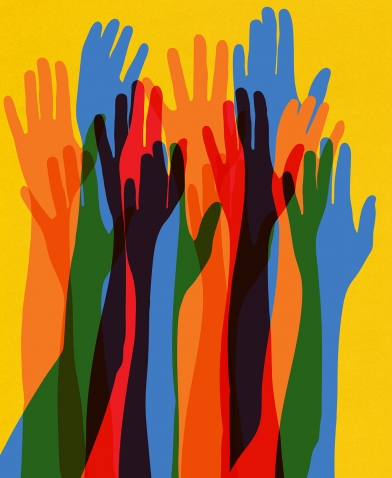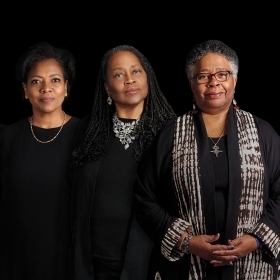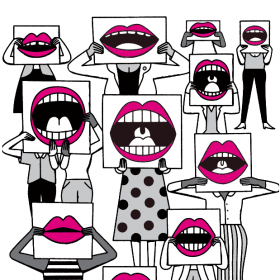When Alessondra Springmann ’07 landed a job at a major observatory in a remote location as a data analyst, observing asteroids passing by Earth with radar, she was elated. She had earned her master’s degree in astronomy at MIT in 2011 and, after difficulty finding a job in the field without a Ph.D., the appointment felt like the opportunity she had been waiting for.
“It was really hard to find a position with a master’s in astronomy, so finally when this job came along, I was so excited. I had finally found something with a really great group of folks,” says Springmann. A planetary radar astronomer now studying asteroids and comets at the University of Arizona’s Lunar and Planetary Laboratory in Tucson, Ariz., she expects to complete her Ph.D. in planetary sciences in the next few years.
A mere month into her 21-month assignment at the remote observatory, Springmann says her work life and feelings about the opportunity changed radically when a visiting scientist began touching her back and shoulders in an inappropriate way. Though she reported this conduct, it wasn’t until he showed up on her doorstep uninvited one evening that her concerns were taken more seriously by observatory management.
“I was living on-site at the observatory. This guy showed up on my porch at 11 p.m. one night and was knocking on the door after I’d told him to stay away from me. I closed all the doors and windows, shut out the lights, and hid under the bed,” she recalls. “I shouldn’t have to deal with that at work.”
Astronomy, like other STEM disciplines—science, technology, engineering, and math—is largely male-dominated. According to statistics from an overview of women in STEM professions conducted by the Economics and Statistics Administration’s Office of the Chief Economist within the Department of Commerce, women filled 47 percent of all U.S. jobs in 2015, but held only 24 percent of STEM jobs. Furthermore, although women constitute slightly more than half of college-educated workers, they make up only 25 percent of college-educated STEM professionals. While Springmann was aware of the gender inequity in her chosen vocation, she had never experienced sexual harassment in other academic settings and was, like many victims, at a loss about how to respond.
“What do you do? How do you report it? I went to talk to the director and he told me he’d take care of it, but it was not clear who to report these things to and how you report these things. The people who were on my side didn’t know what to do,” she says. Springmann describes an “excruciating” conversation she had with the human-resources department, where they blamed her for inviting harassment by talking to the visiting male scientist.
As bad as the harassment was, she says, the response from the organization and human-resources department made it worse. Shortly after Springmann made a formal report, a supervisor several levels above her in the organization came by her office after hours.
“One evening after 5:30 p.m., he knocked on the door. [He] came into my office, and he shut the door and berated me for an hour and a half for reporting the incident. He said harassment reporting devolves into ‘he said, she said.’ It was horrible. I was crying. I just wanted to crawl under my desk. I wanted to quit. I had been there for barely two months at that point,” she says. “I just wanted to do the work. Now I didn’t feel safe doing it.”
Springmann reached out to other women in her field for guidance on how to navigate the situation and found others who had similar experiences. “It’s cultural in fields like astronomy,” she says. “There are many men who harass others at these remote sites, and continually get away with it. Sexual harassment is also common in other fields, and worse in isolated locations. Women doing fieldwork in geology and archaeology experience it, too. Places where no one takes responsibility for maintaining a safe environment are where harassment thrives.”

#MeToo: Across All Industries
Springmann’s experience is a microcosm of the scandal that erupted after the New York Times published an exposé detailing decades of unchecked sexual abuse and harassment of women by film producer Harvey Weinstein early last October. The revelations gave new momentum and a hashtag to the Me Too campaign started by Tarana Burke more than a decade ago after actress Alyssa Milano (who wasn’t initially aware of Burke’s campaign) urged fellow victims of sexual abuse and harassment to reply #MeToo to her tweet. In response, women (and men) from all walks of life and professions started to share their stories on social media and elsewhere, exposing the scope of the problem. The TIME’S UP Legal Defense Fund, housed at and administered by the National Women’s Law Center, soon followed.
In the wake of the growing revelations, a host of prominent men—Charlie Rose, Matt Lauer, and Al Franken, among them—stepped down or were removed from their posts amid allegations of sexual abuse or misconduct.
Not everyone was supportive of the movement either then or now, decrying what was viewed as a “witch hunt” when former colleagues or prominent people they once, perhaps, looked up to fell from grace. The sheer volume of allegations brought against leading figures from all industries, from journalism to business, entertainment to sports, was hard to fathom—or easily dismiss.
Yet, as potent as this moment seems, once the media spotlight moves on, will the public desire and momentum for change falter? There have, after all, been other cultural touchpoints that promised a watershed that never came. Among them are the 1991 Senate Judiciary Committee hearings when Anita Hill described being sexually harassed by her former boss, U.S. Supreme Court nominee Clarence Thomas, and the Take Back the Night movement that took off on college campuses during the same decade. Both carried the promise of systemic change before being sidelined by public backlash.
While Take Back the Night started in the 1970s as a protest against sexual violence and violence against women, it expanded its focus to combating sexual violence of all kinds. Once it gained prominence in the 1990s, it wasn’t long before it became the target of both thoughtful critique and open ridicule in the press, thus effectively trivializing the efforts to mobilize and demand institutional change. Perhaps unsurprisingly, some of the same critics of the Take Back the Night movement, including author Katie Roiphe, who decried the effort as “march as therapy” and “rhapsodies of self-affirmation,” have come out to protest the #MeToo movement as an overreaction by “a certain breed of Twitter feminist.”
To get a sense of what’s at stake and what might come of this moment, perhaps it’s best to start with where we currently stand. After all, when a planetary radar astronomer like Springmann can’t figure out how to navigate systems meant to respond to workplace harassment, there is likely much that needs to be addressed before a turning point can be reached.
Navigating the Law
Springmann’s experience is often the norm, even decades after equal-opportunity statutes like Title VII and Title IX, aimed at eradicating discriminatory behavior, were passed, according to Donna Ballman ’81. (Title VII of the Civil Rights Act of 1964 prohibits employment discrimination based on race, color, religion, sex, and national origin. Title IX, passed in 1972, protects people from discrimination based on sex in education programs or activities that receive federal financial assistance.)
Ballman, a Fort Lauderdale, Fla.-based attorney, whose practice centers on employment law and who has represented employees against unfair labor practices and sexual discrimination for most of her career, says Springmann’s confusion—and the retaliation she faced—is, sadly, par for the course.
“The requirement that people go through the company’s sexual-harassment policy before they can go someplace like the EEOC [Equal Employment Opportunity Commission] and file a lawsuit, it’s impractical. People have to be basically a lawyer to navigate the sexual-harassment laws as they exist. It’s ridiculous. There are so many hoops that they have to jump through,” says Ballman.
She says that not only does Title VII not directly address sexual harassment, the laws governing discrimination in the workplace and educational institutions have impossible standards that need to be simplified and adopted across the board.
“The standard is that [the harassment] has to be so severe or so pervasive that it alters the terms and conditions of employment. Well, that’s a lot, isn’t it? If somebody is groped by their boss, then to them it probably did alter those terms, but if you ask a judge or jury, probably not,” she says.
Fear of Retaliation
Worse still is the reality that when women come forward, despite their fear of not being believed, they—and not the accused—are often punished. A 2016 report on harassment in the workplace by the EEOC found that three out of four individuals who experience harassment (whether sex-based or based on religion, race, disability, or other factors) never report it “because they fear disbelief of their claim, inaction on their claim, or social or professional retaliation.”
“My experience [is] that women who come forward are retaliated against. I don’t think that’s really changing,” says Ballman. “What is changing is that women who come forward publicly [with] multiple women to back their stories are believed, but a single woman who comes forward is pretty much disbelieved.” She adds that often, when colleagues hear about the charges being leveled against a coworker, they shun the victim and not the accused. Frequently, she says, the victim is moved to a different department or location where there are fewer opportunities for advancement or is suspended with pay and, thus, effectively punished.
In addition, many companies continue to assume that the accuser is lying instead of presuming that, like other crime victims, they are telling the truth and starting an investigation from that premise, Ballman says.
“Let’s assume they are telling the truth,” she says. “Let’s investigate and look for witnesses and other people who have worked with these people, former employees who are less likely to be terrified to come forward because of retaliation.”








We ask that those who engage in Wellesley magazine's online community act with honesty, integrity, and respect. (Remember the honor code, alums?) We reserve the right to remove comments by impersonators or comments that are not civil and relevant to the subject at hand. By posting here, you are permitting Wellesley magazine to edit and republish your comment in all media. Please remember that all posts are public.